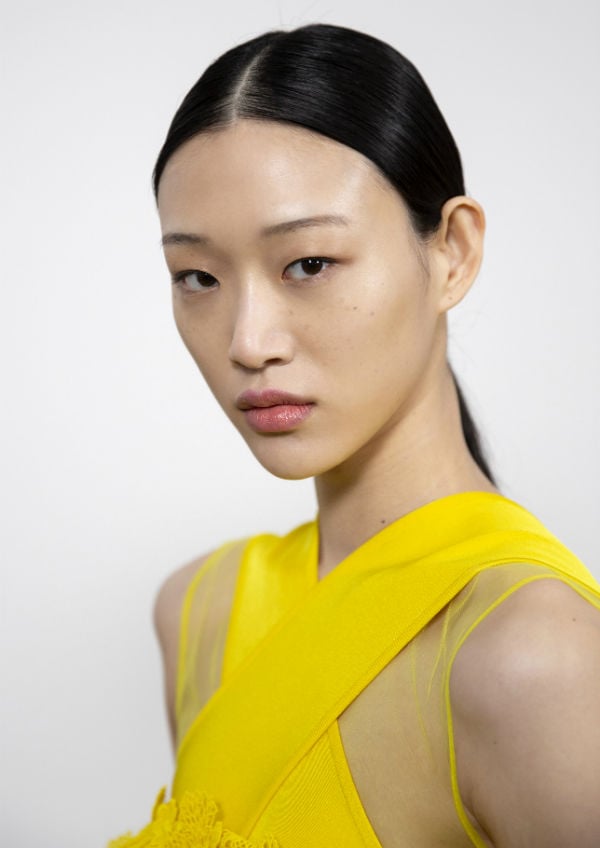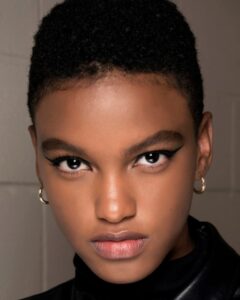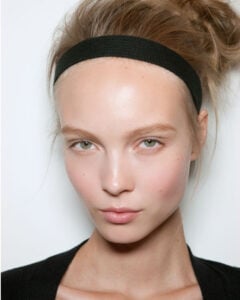If you’re among the millions of conscious consumers who thoroughly analyze the ingredient label before buying your makeup and skincare, you’ve probably seen the words ‘talc-free’ somewhere along the way. While that may have planted the notion that talc is something to be avoided, it’s not really that cut and dry of an issue.
So, what’s the truth about talc in makeup and skincare? The ingredient has been used for its softening properties and absorbency effects since the time of the ancient Egyptians. Today, it’s one of the most common ingredients found in your blushes, eyeshadows, and powder cosmetics. In this piece, we answer ‘is talc bad for your skin?’ and explore the potential side effects of talc in makeup. Armed with that information, you can make an informed decision about purchasing talc-free products.
WHAT IS TALC?
Talc is a naturally occurring mineral that’s chemically known as hydrous magnesium silicate. Mined from the earth, it’s a combination of silicone, oxygen, magnesium, and hydrogen that, together, make up the softest mineral known to man.
It’s this characteristic that makes it a sought-after ingredient in everything from paint and textiles to skin and hair care products. In fact, you’ll find it in baby powder, feminine hygiene products, body and shower products, deodorants, lotions, makeup, and face masks.
HOW IS TALC USED IN MAKEUP?
Talc is a favorite ingredient of the cosmetic industry for good reason. Also found on your ingredients label as talcum powder or cosmetic talc, it has a number of benefits:
- Helps to keep makeup in place and prevent caking.
- Gives facial makeup an opaque finish.
- Improves the feel of a product to make it softer, silkier, more blendable, etc.
- Absorbs moisture such as sweat or your skin’s natural oils.
But perhaps the biggest factor pushing talc to the top of the ingredients list is that it’s a cheap bulking agent. Meaning that it’s used as a filler when working with hefty pigments requiring dilution. This is what makes talc an important part of blushes and eyeshadows, especially those that contain high concentrations of pigment.
THE TALC CONTROVERSY
When Johnson & Johnson was ordered to pay $72 million in a lawsuit that claimed that 35 years of using their talcum powder caused a woman to die of ovarian cancer, the campaign against talc began in full swing. Beyond its association with ovarian cancer, other critics of talc claimed that it can cause lung cancer. This claim is based on a link between inhaling products with talc in them and tumors on the lungs.
However, it’s important to note that the concern around talc’s dangerous side effects has more to do with asbestos than talc itself. Like talc, asbestos is a naturally occurring silicate mineral. In fact, talc and asbestos are often found close to each other on the earth. But while cosmetic-grade talc is meant to be safe for human health, asbestos is a known carcinogen – one that can contaminate talc as it’s being mined in close proximity.
Since the 1960s, there has been scientific research investigating the association between talcum powders and incidences of ovarian cancer. As of yet, none of these studies have proven such a link nor have they come up with substantial evidence regarding potential risk factors.
THE BOTTOM LINE: IS TALC IN MAKEUP BAD FOR SKIN?
The grade of talc used in the cosmetics industry is intended to be of the highest purity. It’s taken from talc deposits that are thoroughly investigated for any potential threat of contamination and mined in such a way that the particles are non-respirable. At this grade, talc is highly stable, chemically inert, and odorless.
For every substance we put on our skin, there is a possibility of having a negative reaction. Generally speaking though, the talc used in cosmetics can be considered safe, beyond the occasional irritation or breakout suffered by people with sensitive or acne-prone skin.
ALTERNATIVES TO TALC IN MAKEUP
If you’re someone with sensitive or breakout-prone skin, less is more. And when there’s any potential for an ingredient to cause irritation, you should avoid it – especially when there are alternatives.
As an alternative to talc, you can look for talc-free products that use ultra-fine mica instead. Mica is a mineral ingredient that’s similar to talc. Instead of a chalky or matte finish, it achieves a frost or a glow. Mica also blends into your skin more seamlessly than talc, so it can dilute color without leaving any of its own pigment behind.
Beyond that, some brands prefer to go talc-free for aesthetic purposes more than safety. Although it helps makeup hold longer, that also means that talc sets and doesn’t move. If you’re looking for a natural and glowy look, you may prefer to use mica regardless of your feelings on talc.
And if you’re curious to explore some makeup options sans talc, check out our in-depth guides on the best talc-free eyeshadow, talc-free setting powders, talc-free blush, talc-free foundation, and talc-free bronzers.
FINAL THOUGHTS
The choice to use talc in your skin and makeup products involves what you feel most comfortable with. One the one hand, there is yet to be any definitive research indicating that talc is toxic or bad for the skin. On the other, talc-free products offer something that those formulated with talc cannot: more flexibility in movement and breathability as well as a dewy finish that’s preferred by those going for a natural look.



